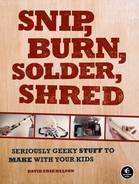Guitarists hungry to craft their own sound often invest in boutique stomp boxes; these are handmade in limited quantities (even unique one-offs) and can cost hundreds of dollars. In the following projects you’ll build three such effects—a reverb unit, a tremolo unit, and a fuzztone—for a grand total of about $20 (likely significantly less if you choose to mail order parts; RadioShack potentiometers and switches are pricey). All three effects rely on modern components to achieve classic sounds using old-school techniques.
The first of these effects is a simple reverb unit. Even with your eyes closed, you can easily tell if you are in a coat closet, bathroom, or gymnasium, because of how the space shapes reverberations: the short-duration, multiply-repeating echoes coming off the walls, floor, and ceiling. The Spring Reverb simulates the sound of playing in an actual space by amplifying your instrument’s signal (using a version of the trusty Dirt-Cheap Amp, Chapter 12) and sending it through a spring. We mix the resulting signal (also called the wet signal), which is replete with reflected echoes generated by the sound bouncing up and down the spring, with the original, unaffected signal (i.e., the dry signal). This is how early amps, like the 1960s Fender Twin Reverb, added a simulated sense of space to the otherwise arid guitar.
a standard soldering kit (See the appendix.)
cyanoacrylate adhesive (CA), such as Krazy Glue
Gorilla Glue, foam-backed double-sided tape, or hardware to mount the reverb tank and circuit in its enclosure
a ruler
an electric drill with 1/4″ and either 1/2″ or 3/8″ bits
a utility or hobby knife
pliers, preferably with built-in snips

